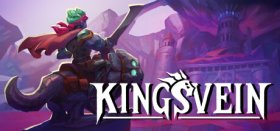
Kingsvein Review
My experiences with turn-based RPGs started with the ever-classic FINAL FANTASY VII; I never really experienced the prior games and their 2D design. I have played them since, but I still don’t have the same connection with the gameplay design that others my age may have. As such, I came to developer Rad Codex’s new game, Kingsvein, with a clear mind.
Kingsvein is a 2D RPG that follows your character as they travel into the titular city to fight the Wisps, a strange species that inhabits dead bodies. Throughout the journey, you’ll make some new friends as well as some deadly enemies. If I’m honest, the plot does take some time to get going; it also takes some time to explain what is going on. For instance, the game held off telling me about the world around me; it never expands on the fact that you don’t play as a human very much or on the types of people you meet. However, Kingsvein gives just enough to keep you invested, although it would be nice to see more from the characters.

The issue is that there isn’t much actual conversation between the characters outside of certain points. The worst offenders are your two friends who never really speak, aside from some token phrases. It feels like something of a missed opportunity for some more information on either the world or the stakes that we were up against. Hell, they could have even been used for some information on our character's past or family, but instead, they just stand there. I did like my mount; it doesn’t speak either, but a retro dragon-horse thing will never not be cute.
Gameplay is another aspect that needs more explanation than what is currently offered. When I started, I’ll be honest, I found it a bit dull. Basically, the game has two modes: exploration and combat. Exploration is just as you’d expect: you walk around completing the odd environmental puzzle until you run into an enemy. When you do, you will be able to set your characters within a grid before the turn-based combat begins, meaning you can put your attackers in front and spell casters behind. Once combat does begin you have a set amount of movement and action points, usually enough for one attack; this is all set around a grid system, which also shows where your weapon can reach. For instance, a sword can only reach a single square in four directions, while a spear can reach two. It works well enough, but there’s one minor problem: a rather languid beginning.

The issue is that Kingsvein suffers from the same problem as a lot of turn-based games: it is initially pretty dull. You don’t start with many skills, so early, fights devolve into just hitting, ending the turn, and then the entire thing starts over again. This limited amount of skills can be an issue when, during the early game, you have to fight hordes of weaker enemies. Your options don’t really extend past hitting them with single attacks over and over again. Thankfully, this does get better over time as you acquire more skills.
It should also be mentioned that this game is difficult, nigh on punishing at the very start; your party can’t do much damage at all compared to the enemies. It also appears that their armour is made of steel, while yours seems to be comprised of paper. It isn’t possible to solo the fights, so you have to outnumber each enemy to beat them quickly. Thankfully, this changes as you gain more levels. If I am honest, the levelling up is one of the standouts in the game. Annoyingly, Kigsvein does have a tendency not to tell you if a specific skill is useful, with some of them being borderline unusable. It is a shame because gaining levels is actually the most interesting part of the game.

Levelling up works like this: you have three base classes and can assign two to each character. These are pretty basic (at least to anyone who has played a videogame ever): you have the rogue, warrior, and wizard. Each of these classes earns its own experience points as you fight; as such, each has its pool of upgrades that it can unlock without affecting the other classes. As a character uses these classes, they unlock new variations that combine them. So if you have a warrior/wizard, they will eventually unlock a new class that combines both and can then move to another class, etc. It's fascinating to play around with, plus the pure variety keeps it interesting. Sadly, the game doesn’t explain it all that well and takes some getting used to.
Kingsvein is visually a love letter to games like FINAL FANTASY VIand CHRONO TRIGGER. It utilises the same retro art style and music to great effect. While the graphics are pretty simple, they mostly convey what they need to. The monsters look especially good at times, although sadly, the world still feels bare. The main party doesn’t fare as well, unfortunately, with each being pretty replaceable both visually and in character, that is, until you meet a certain spear-wielding fox, that is. The music isn’t standout, but it suits the world well enough.
Kingsvein is a game that needs a rewrite of the explanations and a much deeper tutorial. However, there is something here that will draw you in over time. While it took me a while to get into the combat and figure out the difficulty spikes, it became much more enjoyable once I did. If you are willing to put the time in, if only for the levelling alone, then there’s a pretty solid RPG here, even with a pretty bare-bones story.
Kingsvein (Reviewed on Windows)
Game is enjoyable, outweighing the issues there may be.
Kingsvein has some interesting concepts with a novel levelling and class system, but its difficulty and lack of explanation might turn some off.







COMMENTS